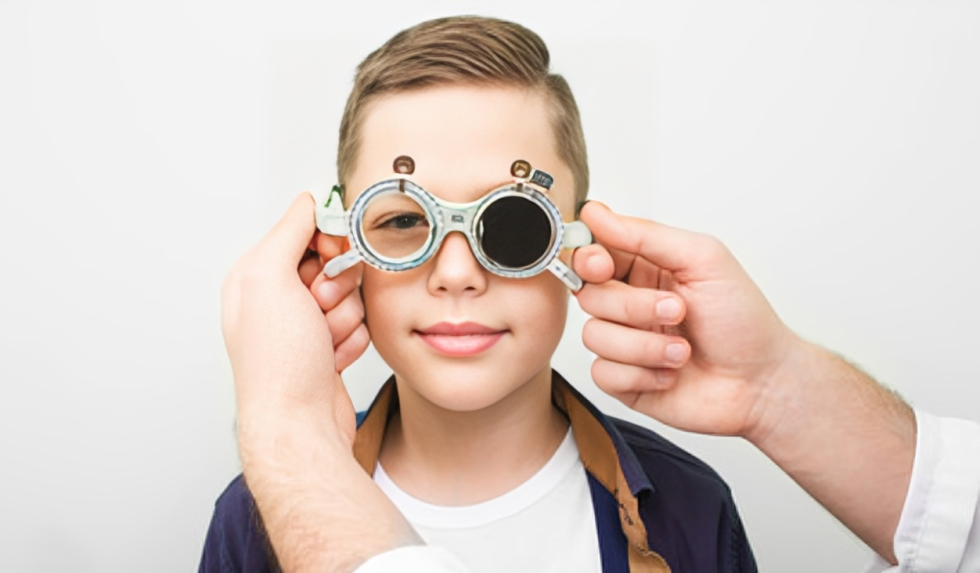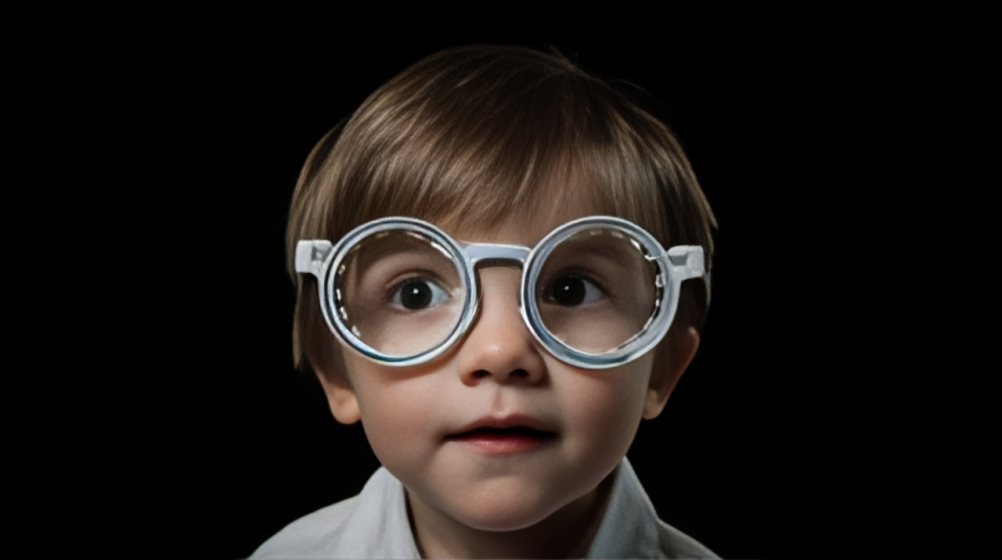Amblyopia is an eye disorder that presents with reduced vision in one eye while the other eye is normal. The brain ignores the blurry eye while the other eye dominates. It is also called “Lazy Eye”. It is one of the common eye disorders and usually occurs in early childhood. Amblyopia affects 3 percent of the population, with a 1.2 percent risk of permanent vision loss.1Webber, A. L., & Wood, J. (2005). Amblyopia: prevalence, natural history, functional effects and treatment. Clinical & experimental optometry, 88(6), 365–375. https://doi.org/10.1111/j.1444-0938.2005.tb05102.x
What Is Amblyopia?
It is an eye disorder that commonly affects children in early childhood. In this condition, one eye has permanently reduced vision while the other has normal vision. The main pathology behind it is a problem in the development of visual pathways. However, there is an abnormality in the transmission of signals to the visual cortex of the affected eye.2Seignette, K., & Levelt, C. N. (2018). Amblyopia: The Thalamus Is a No-Go Area for Visual Acuity. Current biology: CB, 28(12), R709–R712. https://doi.org/10.1016/j.cub.2018.04.081
Causes Of Amblyopia
There are three main causes:
- Deprivation
- Refractive Errors
- Strabismus
Deprivation Amblyopia
Deprivation amblyopia occurs due to any pathology that causes a decrease in the visual stimuli. It can be:
- Cataract
- Corneal Opacity
- Damage to retina
- Vitreous hemorrhage
- Optic nerve pathologies
- Unnecessary covering of one eye
When such pathology decreases the visual stimuli for a long duration, the vision of that eye is masked, and amblyopia occurs.
Strabismic Amblyopia
In strabismus, the visual axis of both eyes is misaligned. One eye looks away from the other, forming two images of the same object; this is called Diplopia. To overcome this effect, our visual system adapts, and the vision of one of our eyes is masked while the other eye functions normally.3Najem, K., & Margolin, E. (2023). Diplopia. In StatPearls. StatPearls Publishing
Refractive Amblyopia
Refractive errors, which include myopia, hyperopia, anisometropia, and astigmatism, can also cause amblyopia. Blurred vision caused by refractive errors can cause amblyopia.
Types Of Amblyopia
There are various types of this condition, and these include the following:
Deprivation Amblyopia
It is the most severe form of amblyopia, which occurs due to obstruction of the visual axis. It is also the least common type of amblyopia.
Refractive Amblyopia
Uncorrected refractive errors cause refractive amblyopia, which can be ametropic or anisometropic. Both eyes have the same refractive errors in ametropic amblyopia, while in anisometropic amblyopia, both eyes have different refractive errors.
Reverse Amblyopia
This type occurs during the treatment of amblyopia. When the normal eye is patched or atropine is used in the normal eye, its vision is masked. It results in the development of amblyopia.
Combined Strabismic And Anisometropic Amblyopia
In this combined type, both strabismus and refractive error occur. It causes suppression of blurred images, and the eye becomes amblyopic.
Meridional Amblyopia
This type occurs from uncorrected astigmatism. Astigmatism causes deprivation of visual stimuli in certain spatial areas and amblyopia occurs as a result.
1.25D of astigmatism can cause amblyopia. It is an amblyopia of a selective visual meridian.
Toxic Amblyopia
Toxic Amblyopia occurs from damage to the optic nerve and optic nerve fibrosis due to the use of harmful substances. These substances include tobacco, alcohol, ethanol, quinine etc.
Signs & Symptoms
In many cases, the patient can not feel he has some problem, and the doctor diagnoses it through a routine medical examination. However, there is a problem with the interaction with objects and the orientation of space. The child may have the following symptoms:
- Squinting an eye a lot
- Keeps one eye closed
- Crossed eyes
- Dropping of eyelids
- Bumps on objects
- Uses one side of the body
- Keeps head tilted on one side
- Reduced visual acuity
- Strabismus
- Poor depth perception (The patient can’t estimate the distance of objects precisely)
- Eye strain

Strabismus can lead to Amblyopia
How Is Amblyopia Diagnosed?
It mostly remains undiagnosed, as the patient can not sense reduced vision in one eye because the other eye is functioning normally. Your doctor will diagnose it by taking a complete history and examining the eyes.
Medical History
Your doctor may ask the following questions while taking the history:
- When did the ocular problem start? Is there any history of trauma, squint, surgery, or refractive error?
- Was the baby born at term, or was it preterm? Was the baby’s birth weight normal at the time of birth?
- Is there any family history of lazy eye? Is there any history of smoking or any substance abuse by the mother during pregnancy?
These are the red flags associated with developing this eye condition in children.
Eye Examination
After a thorough history, your doctor will perform an eye examination. A complete eye examination is necessary to diagnose this eye condition and rule out other eye pathologies.
Visual Acuity
Visual acuity assesses vision clarity. It is the ability of the eye to differentiate shapes, sizes, and details of objects. It is checked using various charts, like Snellen Charts. Your doctor will check the visual acuity of your eyes separately, and if the doctor finds any refractive error, correction should be done.4Caltrider, D., Gupta, A., & Tripathy, K. (2023). Evaluation of Visual Acuity. In StatPearls. StatPearls Publishing.
Swinging Light Reflex Test
The swinging light test detects relative afferent pupillary defects. Relative afferent pupillary defects can occur in amblyopic patients.
Intraocular Pressure Testing
During an eye examination, your doctor will check your eyes’ intraocular pressure to check for any increase in Intraocular Pressure or Glaucoma.
Confrontation Test
In the confrontation test, the examiner compares the patient’s visual field with his own. However, this test assesses your visual field in different planes and any abnormality in vision in any meridian.
Cover Uncover Test
Your doctor will detect Tropias and Phorias (Esophoria or exophoria) by performing a cover uncover test.
This test is performed as follows:
- A healthcare provider will cover each of your eyes alternatingly.
- If present, a deviation will reveal itself even if latent or imperceptible
These tests detect squint, which is the major cause of lazy eye.
Refraction Tests
Your doctor will use an ophthalmoscope to check refractive errors in both eyes. Any difference in vision between the eyes can indicate amblyopia.
Detailed Eye Examination By Using Dilator Substances
A doctor will do a detailed eye examination after dilating the eyes using eye dilators like Atropine. It helps assess any corneal defect, corneal opacity, pathology in the retina, or optic nerve damage.
Treatment Of Amblyopia
Early treatment is important for children because the delay can cause permanent vision loss. The first step for the treatment of lazy eye is the treatment of the underlying cause. The medical treatment consists of using atropine, patching, and corrective surgery for the squint, and if there is some refractive error, it is corrected. The detail of each option is given as follows:
Penalization:
Penalization is the most important and the first step in treating amblyopia. In penalization, the normal eye is covered or patched for a few hours, days, or permanently. The affected eye is allowed to function during this period. In this way, the affected eye has to perform all the visual functions, and its vision improves during penalization. The patient is asked to watch television dramas or play video games to help the eye function maximum.5Chen, A. M., & Cotter, S. A. (2016). The Amblyopia Treatment Studies: Implications for Clinical Practice. Advances in ophthalmology and optometry, 1(1), 287–305. https://doi.org/10.1016/j.yaoo.2016.03.007

Most patients improve after penalizing their normal eye. However, if penalization fails, medical treatment is recommended. The use of atropine is given below.
Bangerter Filter
Bangerter Filter is used to treat lazy eye. Its mechanism of action is blurring the normal eye. Ophthalmologists place a filter in the normal eye, blurring the normal eye so the amblyopic eye has to function more. As a result, its visual function improves.
Medical Treatment:
Medical treatment includes using atropine in the normal eye to reduce or mask its adaptation function. Atropine makes the normal eye unable to function normally, and the amblyopic eye has to function more, so its function improves.
This method is beneficial as the patient has to use one eye drop daily rather than putting on a patch for so many days.6Scheiman, M. M., Hertle, R. W., Kraker, R. T., Beck, R. W., Birch, E. E., Felius, J., Holmes, J. M., Kundart, J., Morrison, D. G., Repka, M. X., Tamkins, S. M., & Pediatric Eye Disease Investigator Group (2008). Patching vs atropine to treat amblyopia in children aged 7 to 12 years: a randomized trial. Archives of ophthalmology (Chicago, Ill. : 1960), 126(12), 1634–1642. https://doi.org/10.1001/archophthalmol.2008.107
Amblyopia improves with the use of atropine in many cases as compared to panalization.
Correction Of The Refractive Errors:
If there is some refractive error in the eye, it is corrected by using lenses, and the visual acuity is maintained to the normal visual acuity. Vision screening and correction of refractive errors are the best options for the early diagnosis and treatment of amblyopia.7US Preventive Services Task Force, Grossman, D. C., Curry, S. J., Owens, D. K., Barry, M. J., Davidson, K. W., Doubeni, C. A., Epling, J. W., Jr, Kemper, A. R., Krist, A. H., Kurth, A. E., Landefeld, C. S., Mangione, C. M., Phipps, M. G., Silverstein, M., Simon, M. A., & Tseng, C. W. (2017). Vision Screening in Children Aged 6 Months to 5 Years: US Preventive Services Task Force Recommendation Statement. JAMA, 318(9), 836–844. https://doi.org/10.1001/jama.2017.11260

Surgical Treatment:
If there are underlying pathologies, surgical treatment is recommended. Surgical treatment options include the following:
Corrective Surgery For Squint
If the patient has strabismus or squint, corrective surgery is suitable to treat the misalignment of the visual axis of the eyes due to squint.
Correction Of Other Eye Pathologies
If you have any other eye pathologies, such as corneal opacities, vitreous hemorrhage, retinal damage, retinal detachment, or optic nerve pathologies, your doctor will correct them by performing their respective surgeries to improve vision and maintain normal eye function.
Eye Exercises:
Eye exercises are also useful in the treatment of this condition. Moreover, your doctor asks you to focus on eye movements and coordination.
Amblyopia Vs. Strabismus
Amblyopia is a problem of visual acuity, while strabismus (squint) is a problem in the alignment of the visual axis of your eyes. In Amblyopia, one eye has reduced vision; in squint, both eyes look in different directions, and there may also be diplopia. Moreover, strabismus involves problems in eye muscle coordination, while amblyopia can be an adaptive response to the squint. A thorough eye examination is necessary to differentiate amblyopia from strabismus.
Amblyopia Vs. Anisometropia
Anisometropia is a type of refractive error in which both eyes have different refractive errors, while amblyopia is a structural or anatomical problem. In fact, it’s our brain’s response to anisometropia. So, we can summarise that amblyopia is the pathology, and anisometropia is the cause. In this case, amblyopia is called “Anisometropic amblyopia.”
Risk Factors
The most common risk factors include family history, developmental delays, preterm birth, low birth weight, CNS disorders, maternal smoking, and substance abuse by the mother.
At What Age Is There Maximum Risk of Amblyopia?
The most common age for developing this eye condition is early childhood. The first few months of life are the most critical period for its development. It is treatable with early diagnosis. However, in older children, its prognosis becomes poor.
8Hunter, D., & Cotter, S. (2018). Early diagnosis of amblyopia. Visual Neuroscience, 35, E013. https://doi.org/10.1017/S0952523817000207
Any delay in the diagnosis and treatment can lead to permanent vision loss and other abnormalities.
Does Vitamin Deficiency Cause Amblyopia?
Amblyopia occurs from a deficiency of vitamins, particularly the Vitamin B complex, including thiamine, niacin, cobalamin, folate, and other vitamins. This type of amblyopia is also called nutritional amblyopia and is treated by supplementing deficient vitamins.
Can Amblyopia Relapse Later On In Life?
If you develop it in your childhood and recover after treatment, there is a 25% chance of its relapse later on in life. So, you must consult your doctor regularly, who will perform a routine eye examination to rule out relapse.
Compilations Of Amblyopia
If this eye condition is not treated in a timely manner, it can cause various complications, such as permanent reduced visual acuity in the affected eye, lifelong vision loss, spatial disorientation, and impaired learning.
Slow reading in children with anisometropic amblyopia is associated with fixation instability and increased saccades.9Journal of AAPOS: the official publication of the American Association for Pediatric Ophthalmology and Strabismus, 21(6), 447–451.e1. https://doi.org/10.1016/j.jaapos.2017.10.001Such patients have visual problems like loss of contrast and difficulty solving multiple-answer questions.10Kelly, K. R., Jost, R. M., De La Cruz, A., & Birch, E. E. (2018). Multiple-Choice Answer Form Completion Time in Children With Amblyopia and Strabismus. JAMA ophthalmology, 136(8), 938–941. https://doi.org/10.1001/jamaophthalmol.2018.2295
Lazy Eye also causes vision deficits, such as problems seeing some objects in a particular spatial dimension. Moreover, it can worsen Strabismus.
Conclusion
Amblyopia, or lazy eye, is a common vision disorder in which one eye has reduced vision while the vision of the other eye is normal. It is common in children, particularly in the early months of life, and it is easily treatable by early diagnosis. It is treated by penalization. If patching fails, medical treatment with atropine is recommended. In the case of refractive amblyopia, the doctors also correct refractive errors. The other treatment options include corrective surgeries for underlying pathologies. It has an excellent prognosis if treated in early childhood.
Refrences
- 1Webber, A. L., & Wood, J. (2005). Amblyopia: prevalence, natural history, functional effects and treatment. Clinical & experimental optometry, 88(6), 365–375. https://doi.org/10.1111/j.1444-0938.2005.tb05102.x
- 2Seignette, K., & Levelt, C. N. (2018). Amblyopia: The Thalamus Is a No-Go Area for Visual Acuity. Current biology: CB, 28(12), R709–R712. https://doi.org/10.1016/j.cub.2018.04.081
- 3Najem, K., & Margolin, E. (2023). Diplopia. In StatPearls. StatPearls Publishing
- 4Caltrider, D., Gupta, A., & Tripathy, K. (2023). Evaluation of Visual Acuity. In StatPearls. StatPearls Publishing.
- 5Chen, A. M., & Cotter, S. A. (2016). The Amblyopia Treatment Studies: Implications for Clinical Practice. Advances in ophthalmology and optometry, 1(1), 287–305. https://doi.org/10.1016/j.yaoo.2016.03.007
- 6Scheiman, M. M., Hertle, R. W., Kraker, R. T., Beck, R. W., Birch, E. E., Felius, J., Holmes, J. M., Kundart, J., Morrison, D. G., Repka, M. X., Tamkins, S. M., & Pediatric Eye Disease Investigator Group (2008). Patching vs atropine to treat amblyopia in children aged 7 to 12 years: a randomized trial. Archives of ophthalmology (Chicago, Ill. : 1960), 126(12), 1634–1642. https://doi.org/10.1001/archophthalmol.2008.107
- 7US Preventive Services Task Force, Grossman, D. C., Curry, S. J., Owens, D. K., Barry, M. J., Davidson, K. W., Doubeni, C. A., Epling, J. W., Jr, Kemper, A. R., Krist, A. H., Kurth, A. E., Landefeld, C. S., Mangione, C. M., Phipps, M. G., Silverstein, M., Simon, M. A., & Tseng, C. W. (2017). Vision Screening in Children Aged 6 Months to 5 Years: US Preventive Services Task Force Recommendation Statement. JAMA, 318(9), 836–844. https://doi.org/10.1001/jama.2017.11260
- 8Hunter, D., & Cotter, S. (2018). Early diagnosis of amblyopia. Visual Neuroscience, 35, E013. https://doi.org/10.1017/S0952523817000207
- 9Journal of AAPOS: the official publication of the American Association for Pediatric Ophthalmology and Strabismus, 21(6), 447–451.e1. https://doi.org/10.1016/j.jaapos.2017.10.001
- 10Kelly, K. R., Jost, R. M., De La Cruz, A., & Birch, E. E. (2018). Multiple-Choice Answer Form Completion Time in Children With Amblyopia and Strabismus. JAMA ophthalmology, 136(8), 938–941. https://doi.org/10.1001/jamaophthalmol.2018.2295

